Market expectations as we began 2024 were that the Fed would lower interest rates several times this year (beginning early in the year).
Instead, inflation measures for January and February were elevated and the Fed has maintained the Fed funds rate at a 5.25% to 5.50% target. The most recent CPI indicators may show some progress on curbing inflation, but it much too early to say that we are heading back towards Jerome Powell 2% inflation target. Meanwhile, but the economy has performed exceptionally well through the beginning of the year with the Dow crossing 40,000. Most economists agree that the economy has adjusted surprisingly well from a low interest rate era to a higher interest rate one.
Chase CEO and Tufts alumnus Jamie Dimon correctly pointed out to Bloomberg last week that significant inflationary forces remain. These include the restructuring of trade, infrastructure requirements of the green economy, remilitarization of the world and fiscal deficits. Dimon, in fact, thinks it is a 50-50 question of whether the Federal Reserve's next move is higher or lower. (The video of Dimon's comments is here.)
Against that backdrop, we really need to ask why the Fed would act now or anytime soon (presumably in September) to cut rates?
It strikes me that there are three realities that could - independently or in some combination - cause the Fed to cut rates before the end of the year.
First, the Fed could see data indicating that the US economy is slowing and act proactively to lower rates to try to extend the economic cycle. There however is nothing in the data today suggesting any sort of slowing of the economy.
Second, the Fed could lower rates in response to a banking crisis, presumably one that results from high rates causing a cascading effect in commercial real estate resulting in many regional banks becoming illiquid. Jerome Powell, however, has been asked in press conferences whether this would cause a crisis that the Fed might respond to and has indicated that it might not, and the Fed let the Treasury contain the Silicon Valley Bank failure in 2023.
Third, there could be political influences ahead of the election that the Fed would be responsive to. It however is starting to seem unlikely that the Biden administration would try to encourage a Fed move before the election as polls show that voters are not crediting him with the strong economy but that are blaming him for inflation. Were they however to call for lower rates, Powell and the Fed could be prompted to act, especially as Trump is also calling for lower rates now. Powell did lower rates for no reason after Trump jawboned him into it in July 2019.
Unless you believe that one, two or all three of the above are likely to materialize soon, it might be best stay in savings for now.














Comments
smithy1968
May 22, 2024
Ari, Isn't it possible that Diman is saying this stuff to push his own agenda and Chase's own book? Banks may money borrowing at the short end and lending at the long end of the yield curve. If you run the largest bank in the country, you want to say whatever you want to say in order to try to un-invert the yield curve after two years. Saying that inflation is going to be with us forever because of this, this, this and this is the easiest way to do it.
Is this review helpful? Yes:0 / No: 1
Add your Comment
or use your BestCashCow account